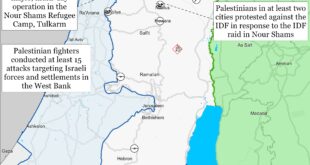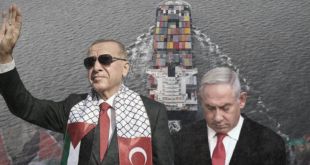1. The Western Balkans area is situated along the main fault line of the Huntington-type “clash of civilizations” in Europe:
a) Between Christianity and Islam – resulted in the main Muslim enclave in Europe (Albania + Kosovo)
b) Between Western Christianity (Catholic/Protestant) and Orthodoxy – resulting in splitting the Slavic people
2. After World War II and during the Cold War a new ideological fault line was created, between communist and capitalist spheres of influence.
The splitting was decided during World War II, on 9 October 1944, at a meeting in the Kremlin between Winston Churchill and Stalin, accompanied by the respective foreign ministers. During the negotiations that took almost the whole night, Churchill wrote on a scrap of paper that Stalin had a 90 percent “interest” in Romania, Britain a 90 percent “interest” in Greece, both Russia and Britain a 50 percent interest in Yugoslavia. When they got to Italy, Stalin ceded that country to Churchill. The crucial questions arose when the Ministers of Foreign Affairs discussed “percentages” in Eastern Europe. Molotov’s proposals were that Russia should have a 75 percent interest in Hungary, 75 percent in Bulgaria, and 60 percent in Yugoslavia. This was Stalin’s price for ceding Italy and Greece. Eden tried to haggle: Hungary 75/25, Bulgaria 80/20, but Yugoslavia 50/50. After lengthy bargaining they settled on an 80/20 division of interest between Russia and Britain in Bulgaria and Hungary, and a 50/50 division in Yugoslavia (encl. excerpt from Churchill’s memoirs).
Consequently, the Yugoslav federation found itself between the confronting interests of the U.S.-led North Atlantic Treaty Organization and the Soviet-led Warsaw Pact.
3. The Yugoslav state created by Josip Broz Tito might be seen as an attempt to overcome the fault lines.
a) Internally, Tito managed to successfully maintain the peaceful coexistence of the nations of the Yugoslav federation. He was the chief architect of the Socialist Federal Republic of Yugoslavia, a socialist federation that lasted from 1943 to 1992. His internal policies included the suppression of nationalist sentiment and the promotion of the “brotherhood and unity” of the six Yugoslav nations.
– On the economic side, in 1948, motivated by the desire to create a strong independent economy, Tito modeled his economic development plan independently from Moscow, which resulted in a diplomatic escalation and Yugoslavia’s splitting with the Stalin-led communist bloc. In 1949, the crisis nearly escalated into an armed conflict, as Hungarian and Soviet forces were massing on the northern Yugoslav frontier.
b) In ideological and international terms, especially after Stalin’s death in 1953, Tito played the East-West antagonism to his advantage. Instead of choosing sides, he was instrumental in kick-starting the Non-Aligned Movement, which would function as a “third way” for countries interested in staying outside of the East-West divide.
The Non-Aligned Movement was founded in 1961 by Josip Broz Tito, Egypt’s Gamal Abdel Nasser, India’s Jawaharlal Nehru, Indonesia’s Sukarno and Ghana’s Kwame Nkrumah, in an action called “The Initiative of Five” (Tito, Nehru, Nasser, Sukarno, Nkrumah).
4. The so-called “Titoism” and the non-aligned doctrine are also to be seen as an attempt to bridge the religious fault line between Christianity and Islam.
a) One of the moves was to create the concept of a “Muslim nationality” for the population in the current-day Bosnia and Herzegovina, by including in the Constitution of Yugoslavia the term of “Muslims” in a national sense.
However, the Tito regime did not allow radical Islam as proposed by Alija Izetbegovic, who was several times sentenced to jail.
In the late 1930s and early 1940s, Izetbegovic and a circle of devout Islamists formed a group called the Mladi Muslimani (“Young Muslims”), inspired by the Muslim Brotherhood in Egypt. In Izetbegovic’s own words, the goal of the Mladi Muslimani was the creation of “one great Muslim state,” or, as a Bosnian historian has described, the creation of an “Islamistan” throughout the Balkans, northern Africa, and the Middle East.
In 1946, Josip Broz Tito’s Communist regime arrested a large number of the Mladi Muslimani, including Izetbegovic himself. Imprisonment, however, did not deter Izetbegovic from the Islamist cause, and in his most famous political manifesto, the Islamic Declaration of 1970, he declared that there could be “no peace or co-existence between Islamic faith and non-Islamic social and political institutions”. The views promoted in the Islamic Declaration, earned Izetbegovic a second prison term in 1983, along with a dozen other Islamist activists in Bosnia.
b) The “non-aligned” status of Yugoslavia and the links with Nasserist Egypt fostered also Yugoslavia’s Islamic religious ties with Egypt.
Even today, Bosnia’s senior Muslim clergy are all graduates of Cairo’s Al-Azhar University, and the Mufti of Belgrade, married to an Egyptian, is an active participant in Arab conferences. Every year, during the Muslim fasting month of Ramadan, Al-Azhar dispatches clerics to Yugoslavia to lead prayers.
5) Tito’s death, as well as the collapse of communism in the late 1980s resulted in the resurgence of the fault lines and conflicts, and the multi-ethnic and multi-confessional federation collapsed into small client states, in a centrifugal process of splitting from one-another.
The death of the Federal Socialist Republic of Yugoslavia President Tito in 1980, and than that of his protégé and successor, Vladimir Bakaric, in 1983, produced a void in the leadership of the Yugoslavia. As a result, throughout the remainder of the 1980s, Yugoslavia suffered from a declining economy, increasing rivalry between individuals and states, and the rebirth of nationalism closely allied to one of the three religions, Christian Roman Catholicism, Christian Orthodoxy and Islam. Three leaders emerged, each one using the emotive appeal of patriotism (nationalism), history and religious heritage in their bid for political control of one of the three nation “nation states”, Orthodox Christian Serbia, Roman Catholic Christian Croatia and Islamic Bosnia-Herzegovina.
a) The Muslim groups in Bosnia, Kosovo and Sandzak tend to get closer to neighboring Albania, where the Muslims are in a majority with 60-70% (Hanafi, Wahhabi, Sufi).
Also significant are their new ties with the Muslim Brotherhood in Europe, as exampled by the Vienna based Kelimet ul-Haq. This is seen as bound to develop as a so-called “green Muslim corridor” in Europe.
b) The Catholic and reformate groups (together with Croatia and Slovenia) are getting closer to the West, especially Hungary which attracts the catholic cum reformate populations in Albania (30-40%) and the Serbian province of Vojvodina.
c) Orthodox Serbia (and Montenegro) are subject to a sustained policy of Russia to attract them in Moscow’s sphere of influence, making use of the Orthodoxy and Slavic arguments.
Annex
The spheres of influence partition, 1944
Excerpt from: Winston Churchill: Triumph & Tragedy, Houghton Mifflin, Boston, 1953, pp. 226 – 228
“We alighted at Moscow on the afternoon of October 9… At ten o’clock that night we held our first important meeting at the Kremlin. There were only Stalin, Molotov, Eden, and I… The moment was apt for business, so I said, «Let us settle about our affairs in the Balkans. Your armies are in Rumania and Bulgaria. We have interests, missions and agents there. Don’t let us get at cross-purposes in small ways. So far as Britain and Russia are concerned, how would it do for you to have ninety per cent predominance in Rumania, for us to have ninety per cent of the say in Greece, and go fifty-fifty about Yugoslavia?» While this was being translated I wrote out on a half-sheet of paper:
Rumania
– Russia 90 %
– The others 10 %
Greece
– Great Britain 90 % (in accord with U.S.A.)
– Russia 10 %
Yugoslavia 50-50 %
Hungary 50-50 %
Bulgaria
– Russia 75 %
-The others 25 %
I pushed this across to Stalin, who had by then heard the translation. There was a slight pause. Then he took his blue pencil and made a large tick upon it, and passed it back to us. It was settled in no more time than it takes to set down…
After this there was a long silence. The pencilled paper lay in the center of the table. At length I said, «Might it not be thought rather cynical if it seemed we had disposed of these issues, so fateful to millions of people, in such an offhand manner? Let us burn the paper». «No, you keep it», said Stalin”.
 Eurasia Press & News
Eurasia Press & News



